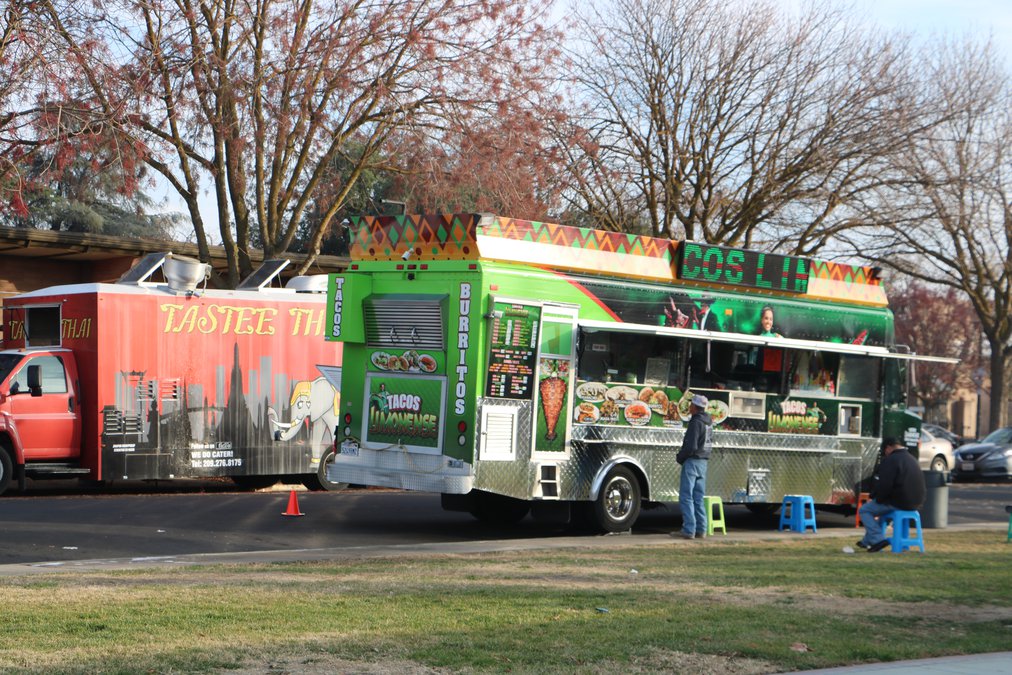There was a bit of irony at Library Park Wednesday afternoon
Across from the park on the shortest street in Manteca — Pierce Avenue that runs for perhaps 100 feet from Manteca Avenue to Yosemite Avenue — two restaurants were banned from allowing outside diners under California’s COVID-19 shutdown mandates.
Under the stately sycamore trees of Library Park, though, were two couples and a solitary construction worker making use of picnic tables and benches to enjoy Thai dishes and Mexican cuisine they had just purchased from two of three food trucks parked along Poplar Avenue on the west side of Library Park.
Parks have not been shut down as they were at the start of the pandemic in March. And given there was much more than six feet of separation from dining “cohorts” in the wide open air that was a brisk 57 degrees, there clearly was minimum health risks.
But that is not the risk the Manteca City Council had in mind Tuesday when they passed an emergency ordinance giving City Manager Miranda Lutzow the authority to temporarily allow food trucks outside of bars, microbreweries, and wine tasting rooms once the current COVID-19 surge recedes so California can return to the four-color coded groupings of pandemic restrictions that loosen as you go from purple down to red, orange, and then yellow.
City leaders are worried that a number of Manteca businesses will be victims of the pandemic. It means more than just lost livelihoods for owners, jobs for workers, and revenue for the city. It would also create holes in Manteca’s economy that may take years to fill.
It is why after making it possible for a bar partnering with a food truck to be allowed to reopen when San Joaquin County returns to the purple tier that couldn’t otherwise open until COVID-19 cases literally plummet, the council was hesitant to instruct the staff to comeback with an ordinance that would make the food truck/bar combo permanent as at least one microbrewery owner wanted them to do.
Councilman Gary Singh said he was worried that allowing food trucks on a permanent basis after the health emergency is over would essentially make it impossible for some restaurants that are now struggling to recover.
Planner J.D. Hightower pointed to studies — including one involving the City of Alameda in the Bay Area — that food trucks in proximity of brick and mortar restaurants create a synergy that allows nearby traditional dining establishments to see a 6 to 7 percent increase in sales.
Singh emphasized that the pandemic has created a different reality — at least for the time being.
“I don’t want to see us do something that hurts the brick and mortar restaurants that are struggling (due to the pandemic rules curtailing their business),” Singh said.
He added restaurants are saddled with significantly more fixed costs than food trucks ranging from rent and property taxes to larger staffs who they are trying to keep employed.
Unless the state shuts down takeout food operations, the business model of food trucks is pandemic-proof.
Singh, who led the charge to launch the food truck pilot program at Library Park back in August, cited the City of Alameda study to make his case back then.
On Tuesday, however, he noted COVID-19 rules have changed the dynamics of public engagement and dining essentially making the Alameda study moot until such time there is a return to some version of pre-pandemic normalcy.
The City Council was scheduled to assess the food truck pilot program in March and decide whether to make it permanent at Library Park and possibly expand it to other locations in Manteca but then the pandemic hit.
The city also dropped events planned for Library Park using the food trucks to create a drawing card of sorts when public gatherings were prohibited.
And if Lutzow does proceed with allowing bars and such to have food trucks and locations that are landlocked — so to speak — by having no or minimum outdoor space except for adjacent street parking are accommodated as well, Pierce Avenue could end up being a prime example of a city solution that works around Sacramento dictates to give as many local businesses a chance at surviving.
There are three businesses on the short stretch of Pierce Avenue. On one end is My Friends Place and on the other is Anna’s Asian Palace. Sandwiched in between is the Xtreme Sports Bar.
Right now the two restaurants can open for takeout and delivery only. The bar can’t open. When things move back into the purple zone the restaurants could add several outdoor dining tables but the bar would still be closed.
And when inside dining returns at 25 percent occupancy in the red tier the bars still couldn’t open because they don’t serve food.
Thanks to the decision by the council, if the bar has the ability for its patrons to purchase alcohol in conjunction with food they will be under the same rules governing restaurants.
However the bar may have to wait until the red tier to do so if for some reason chairs and tables in front of its location on a city sidewalk doesn’t suffice or if an issue is made of the food truck being parked on a public street.
That said the staff report for the emergency ordnance references “expanding the food truck pilot program to locations in close proximity to bars, nightclubs, brew pubs, and tasting rooms” eschewing any specific reference they have to be on property with where alcohol is being served.
The council’s decision on Tuesday adopting the emergency ordinance to allow teaming food trucks with bars to essentially out them on the same footing as restaurants could have a positive impact on six microbreweries and bars in Manteca.
To contact Dennis Wyatt, email dwyatt@mantecabulletin.com





